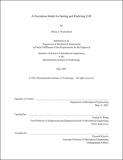| dc.contributor.advisor | Wang, Evelyn N. | |
| dc.contributor.author | Wyttenbach, Minna Z. | |
| dc.date.accessioned | 2022-08-29T16:25:42Z | |
| dc.date.available | 2022-08-29T16:25:42Z | |
| dc.date.issued | 2022-05 | |
| dc.date.submitted | 2022-06-14T19:35:44.627Z | |
| dc.identifier.uri | https://hdl.handle.net/1721.1/144990 | |
| dc.description.abstract | Boiling is a ubiquitous process in numerous applications, characterized by the heat transfer coefficient (HTC) and critical heat flux (CHF). Exceeding CHF can result in catastrophic failure of a system, making it an important value to understand; however, there is no universal model for predicting it. A recently investigated way to model CHF uses percolation theory, which states that CHF is reached at the percolation threshold. A bubble percolation model is used to visualize and predict boiling performance. The predictions of these models will then be used for characterizing the boiling performance of sandblasted surfaces, for which there are ongoing experiments. | |
| dc.publisher | Massachusetts Institute of Technology | |
| dc.rights | In Copyright - Educational Use Permitted | |
| dc.rights | Copyright MIT | |
| dc.rights.uri | http://rightsstatements.org/page/InC-EDU/1.0/ | |
| dc.title | A Percolation Model for Boiling and Predicting CHF | |
| dc.type | Thesis | |
| dc.description.degree | S.B. | |
| dc.contributor.department | Massachusetts Institute of Technology. Department of Mechanical Engineering | |
| mit.thesis.degree | Bachelor | |
| thesis.degree.name | Bachelor of Science in Mechanical Engineering | |
